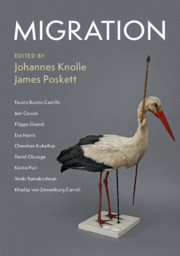Refine search
Actions for selected content:
3430 results in Popular science
4 - What Algorithms Do
-
- Book:
- The Age of Algorithms
- Published online:
- 17 March 2020
- Print publication:
- 16 April 2020, pp 29-35
-
- Chapter
- Export citation
13 - Personal Data and Privacy
-
- Book:
- The Age of Algorithms
- Published online:
- 17 March 2020
- Print publication:
- 16 April 2020, pp 104-114
-
- Chapter
- Export citation
14 - Fairness, Transparency, and Diversity
-
- Book:
- The Age of Algorithms
- Published online:
- 17 March 2020
- Print publication:
- 16 April 2020, pp 115-124
-
- Chapter
- Export citation
Contents
-
- Book:
- The Age of Algorithms
- Published online:
- 17 March 2020
- Print publication:
- 16 April 2020, pp v-v
-
- Chapter
- Export citation
6 - Computational Thinking
-
- Book:
- The Age of Algorithms
- Published online:
- 17 March 2020
- Print publication:
- 16 April 2020, pp 45-52
-
- Chapter
- Export citation
12 - The Responsibility of Algorithms
-
- Book:
- The Age of Algorithms
- Published online:
- 17 March 2020
- Print publication:
- 16 April 2020, pp 96-103
-
- Chapter
- Export citation
9 - The End of Property
-
- Book:
- The Age of Algorithms
- Published online:
- 17 March 2020
- Print publication:
- 16 April 2020, pp 70-80
-
- Chapter
- Export citation
16 - Computer Science Education
-
- Book:
- The Age of Algorithms
- Published online:
- 17 March 2020
- Print publication:
- 16 April 2020, pp 133-142
-
- Chapter
- Export citation
10 - Governing in the Age of Algorithms
-
- Book:
- The Age of Algorithms
- Published online:
- 17 March 2020
- Print publication:
- 16 April 2020, pp 81-88
-
- Chapter
- Export citation
2 - What Is an Algorithm?
-
- Book:
- The Age of Algorithms
- Published online:
- 17 March 2020
- Print publication:
- 16 April 2020, pp 5-18
-
- Chapter
- Export citation
20 - Time to Choose
-
- Book:
- The Age of Algorithms
- Published online:
- 17 March 2020
- Print publication:
- 16 April 2020, pp 160-160
-
- Chapter
- Export citation

Migration
-
- Published online:
- 25 March 2020
- Print publication:
- 04 June 2020

The Age of Algorithms
-
- Published online:
- 17 March 2020
- Print publication:
- 16 April 2020
Index
-
- Book:
- The Cosmic Revolutionary's Handbook
- Published online:
- 25 November 2019
- Print publication:
- 04 February 2020, pp 277-278
-
- Chapter
- Export citation
Copyright page
-
- Book:
- The Cosmic Revolutionary's Handbook
- Published online:
- 25 November 2019
- Print publication:
- 04 February 2020, pp iv-iv
-
- Chapter
- Export citation
6 - The Wood for the Trees
-
- Book:
- The Cosmic Revolutionary's Handbook
- Published online:
- 25 November 2019
- Print publication:
- 04 February 2020, pp 122-145
-
- Chapter
- Export citation
6 - The Wood for the Trees
-
- Book:
- The Cosmic Revolutionary's Handbook
- Published online:
- 25 November 2019
- Print publication:
- 04 February 2020, pp 122-145
-
- Chapter
- Export citation
8 - Ripples in the Night Sky
-
- Book:
- The Cosmic Revolutionary's Handbook
- Published online:
- 25 November 2019
- Print publication:
- 04 February 2020, pp 174-200
-
- Chapter
- Export citation
2 - How Dark Is the Night?
-
- Book:
- The Cosmic Revolutionary's Handbook
- Published online:
- 25 November 2019
- Print publication:
- 04 February 2020, pp 24-45
-
- Chapter
- Export citation
Contents
-
- Book:
- The Cosmic Revolutionary's Handbook
- Published online:
- 25 November 2019
- Print publication:
- 04 February 2020, pp vii-viii
-
- Chapter
- Export citation
